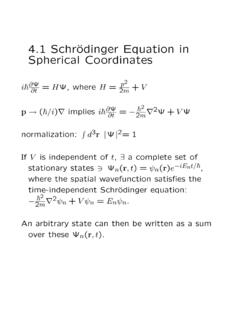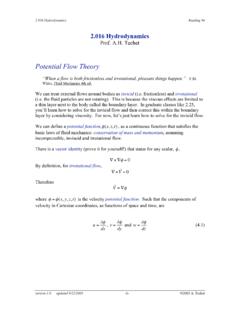Transcription of Human Visual System - Washington State University
1 Human Visual System In many image processing applications, the objective is to help a Human observer perceive the Visual information in an image. Therefore, it is important to understand the Human Visual System . The Human Visual System consists mainly of the eye (image sensor or camera), optic nerve (transmission path), and brain (image information processing unit or computer). It is one of the most sophisticated image processing and analysis systems. Its understanding would also help in the design of efficient, accurate and effective computer/machine vision systems. Cross-section of the Human Eye Cross-section of the Human Eye Nearly spherical with a diameter of 20 mm (approx.)
2 Cornea --- Outer tough transparent membrane, covers anterior surface. Sclera --- Outer tough opaque membrane, covers rest of the optic globe. Choroid --- Contains blood vessels, provides nutrition. Iris --- Anterior portion of choroid, pigmented, gives color to the eye. Pupil --- Central opening of the Iris, controls the amount of light entering the eye (diameter varies from 2-8 mm). Lens --- Made of concentric layers of fibrous cells, contains 60-70% water. Retina --- Innermost layer, screen on which image is formed by the lens when properly focussed, contains photoreceptors (cells sensitive to light). Retinal Photoreceptors Two types of photoreceptors: rods and cones (light sensors).
3 Cones --- 6-7 million, located in central portion of retina (fovea), responsible for photopic vision (bright-light vision). and color perception, can resolve fine details. Rods --- 75-150 million, distributed over the entire retina, responsible for scotopic vision (dim-light vision), not color sensitive, gives general overall picture (not details). Fovea --- Circular indentation in center of retina, about diameter, dense with cones. Photoreceptors around fovea responsible for spatial vision (still images). Photoreceptors around the periphery responsible for detecting motion. Blind spot --- Point on retina where optic nerve emerges, devoid of photoreceptors.
4 Distribution of Rods and Cones on Retina Simple model for image formation Object height S. Visual Angle A. Inverted Visual Axis Projection P. Distance from Object d Image Distance l Distance between center of lens and retina varies from 14- 17mm. Farther the object, smaller the refractive power of lens, larger the focal length. From the geometry, S 15. P=l = 17 = d 100 . S. A = tan 1 = .. d Brightness Adaptation Human eye can adapt to an enormous range of light intensity levels, almost 10 orders of magnitude! Brightness perceived (subjective brightness) is a logarithmic function of light intensity. Eye cannot simultaneously operate over such a range of intensity levels.
5 This is accomplished by changing the overall sensitivity --- Brightness adaptation. At a given sensitivity, the eye can simultaneously discriminate only a small number of intensity levels. For a given condition, the sensitivity of the Visual System is called the brightness adaptation level (ex. Ba ). At this adaptation, the eye can perceive brightness in the range Bb (below which, everything is perceived as black) to Ba (above which, the eye adapts to a different sensitivity). Brightness Discrimination The ability of the eye to discriminate between changes in brightness levels is called brightness discrimination. The increment of intensity Ic that is discriminable over a background intensity of I is measured.
6 Weber ratio --- it is the ratio Ic / I. Small value of Weber ratio --- good brightness discrimination, a small percentage change in intensity is discriminable. Large value of Weber ratio --- poor brightness discrimination, a large percentage change in intensity is required. At high intensities the brightness discrimination is good (small Weber ratio), than at low intensities. Perceived Brightness is not a Simple Function of Light Intensity Simultaneous Contrast A region's perceived brightness is not a function of only its intensity, but depends on the background intensity as well. All the center squares in the figure below have exactly the same intensity.
7 However, they appear to the Human eye to become darker as the background becomes brighter. Optical Illusion The fills in non-existent information or wrongly perceives geometrical properties of objects. See Figure of text for some examples Light and EM Spectrum Electromagnetic (EM) waves or radiation can be visualized as propogating sinusoidal waves with some wavelength or equivalently a frequency where = c , c being the velocity of light. Equivalently, they can be considered as a stream of (massless). particles (or photons), each having an energy E proportional to its frequency ; E = h , where h is Planck's constant. EM spectrum ranges from high energy radiations like gamma- rays and X-rays to low energy radiations like radio waves.
8 Light is a form of EM radiation that can be sensed or detected by the Human eye. It has a wavelength between to micron. Different regions of the visible light spectrum corresponds to different colors. Light that is relatively balanced in all visible wavelengths appears white ( is devoid of any color). This is usually referred to as achromatic or monochromatic light. The only attribute of such light is its intensity or amount. It is denoted by a grayvalue or gray level. White corresponds to the highest gray level and black to the lowest gray level. Three attributes are commonly used to describe a chromatic light source: o Radiance is the total amount of energy (in unit time) that flows from the source and it is measure in Watt (W).
9 O Luminance is a measure of the amount of light energy that is received by an observer. It is measured in lumens (lm). o Brightness is a subjective descriptor of light measure (as perceived by a Human ). The wavelength of EM radiation used depends on the imaging application. In general, the wavelength of an EM wave required to see . an object must be of the same size (or smaller) than that of the object. Besides EM waves, other sources of energy such as sound waves (ultra sound imaging) and electron beams (electron microscopy) are also used in imaging. Image Sensing and Acquisition A typical image formation System consists of an illumination source, and a sensor.
10 Energy from the illumination source is either reflected or absorbed by the object or scene, which is then detected by the sensor. Depending on the type of radiation used, a photo-converter ( , a phosphor screen) is typically used to convert the energy into visible light. Sensors that provide digital image as output, the incoming energy is transformed into a voltage waveform by a sensor material that is responsive to the particular energy radiation. The voltage waveform is then digitized to obtain a discrete output. Read Sections for some more details about sensors. Mathematical Representation of Images An image is a two-dimensional signal (light intensity) and can be represented as a function f (x, y).














